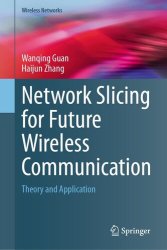 Название: Network Slicing for Future Wireless Communication: Theory and Application
Название: Network Slicing for Future Wireless Communication: Theory and ApplicationАвтор: Wanqing Guan, Haijun Zhang
Издательство: Springer
Серия: Wireless Networks
Год: 2024
Страниц: 122
Язык: английский
Формат: pdf (true), epub
Размер: 17.3 MB
This book comprehensively discusses the development, application and challenges of network slicing technology in wireless communications. Starting with the basic concept and enabling technologies of network slicing, this book introduces how to integrate AI (Artificial Intelligence) technology into the end-to-end deployment, resource allocation and performance enhancement for multi-tenant slicing. An in-depth exploration of managing multi-domain slices deployed in the federated infrastructure networks is presented, including on-demand cooperation among multiple infrastructure networks, distinct slice deployment, hierarchical slice orchestration and fast slice adaption. As a guide to leveraging AI to enhance traffic performance of multi-tenant slicing and customize resource slicing for industrial scenarios, this book provides insights, modeling, applications and research issues. A holistic perspective on prominent role of network slicing in managing wireless network resources is provided as well.
Fifth-generation (5G) networks have been deployed commercially at the end of 2019 and researches on sixth-generation (6G) networks are under way in several countries and organizations. In the coming era of 6G, applications such as augmented or virtual reality (AR/VR), unmanned aerial vehicles (UAV), fully autonomous driving, satellite-ground communications, etc. are forcing mobile network operators (MNOs) to carry the complex scenarios and deliver diverse services. Following these applications, scenarios supported by 6G include further enhanced mobile broadband (FeMBB), ultra-massive machine-type communications (umMTC), extremely ultra-reliable and low-latency communications (eURLLC), long-distance and high-mobility communications (LDHMC), and extremely low-power communications (ELPC).
The core of network slicing is the implementation process of a network slicing instance. An instance consists of multiple virtual network functions (VNFs) and computing, storage, and network resources across multiple technical domains, including radio access network (RAN), transport network, core network, and data centers that manage third-party applications in industry verticals. The implementation of network slicing is based on the following three important principles:
• Isolation. Slices must be isolated from each other, so that congestion or failure on one slice will not affect other slices. However, isolation may come at the cost of reduced multiplexing gain, which results in lower network resource utilization.
• Customization. Resources allocated to a specific tenant must be effectively utilized to meet the corresponding service requirements to the maximum extent.
• End-to-end (E2E). It includes two aspects: (i) slices need to span different administrative domains, which means that a slice occupies heterogeneous resources provided by different infrastructure network providers (InPs); (ii) slices need to across different technology domains, including RAN domain, transport network domain, and core network domain.
A network slice is defined by International Telecommunication Union (ITU) as a logically isolated network partition consisting of multiple VNFs, which is isolated and equipped with a programmable control plane and a data plane. The VNFs that constitute the network slice may vary greatly according to specific service requirements. The service types associated with the network slice determine the resources allocated to this network slice and the corresponding processing flow. The realization of network slicing is inseparable from software defined network (SDN) architecture and network function virtualization (NFV) technology. SDN architecture is an appropriate technology for the configuration and control of the forwarding planes of the underlying resources, while NFV can manage the life cycle of network slices and orchestrate VNFs efficiency. As the key technologies to realize network slicing, SDN and NFV enable network components to run on virtualized infrastructure networks in the form of software and provide virtual resources according to the requirements of slices.
Скачать Network Slicing for Future Wireless Communication: Theory and Application